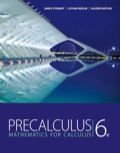
Concept explainers
a.
To find the value of
a.
Answer to Problem 12RE
The answer is
Explanation of Solution
Given:
The graph of function f is given.
Concept Used:
The concept of graphing of functions is used.
In the graph, when x = -2 , y = -1. So
b.
To find the domain of f .
b.
Answer to Problem 12RE
The domain of
Explanation of Solution
Given:
The graph of function f is given.
Concept Used:
The concept of domain of functions is used.
In the graph, x can take values between -4 and 5, both included. Hence the domain of f = [-4, 5].
c.
To find the range of f .
c.
Answer to Problem 12RE
The range of
Explanation of Solution
Given:
The graph of function f is given.
Concept Used:
The concept of range of functions is used.
In the graph, y can take values between -4 and 4, both included. Hence the range of f = [-4, 4].
d.
To tell the intervals where f is increasing and decreasing.
d.
Answer to Problem 12RE
The intervals where f is increasing are: (-4, -2) and (0, 4).
The intervals where f is decreasing are: (-2, 0) and (4, 5).
Explanation of Solution
Given:
The graph of function f is given.
Concept Used:
The concept of increasing and decreasing functions is used.
The intervals where f is increasing are: (-4, -2) and (0, 4).
The intervals where f is decreasing are: (-2, 0) and (4, 5).
e.
To find the
e.
Answer to Problem 12RE
The local maximum value of f = 4 at x=4.
Explanation of Solution
Given:
The graph of function f is given.
Concept Used:
The concept of local maximum value of functions is used.
The local maximum value of f =4 at x=4.
e.
To check if
e.
Answer to Problem 12RE
No, f is not one to one.
Explanation of Solution
Given:
The graph of function f is given.
Concept Used:
The concept of one to one functions is used.
In the graph of f, f(-2)=f(0). Hence the function f is not one to one.
Chapter 2 Solutions
EBK PRECALCULUS: MATHEMATICS FOR CALCUL
- Use the two methods "real number solution space basis" and "complex solution space basis" respectively to solve y''+ 1/4y = 0, y(π) = 1, y'(π) = -1arrow_forwardExplain the key points of Theroem 9.3.6arrow_forwardProve that if a and b are both positive, then y(x)⭢0 as x⭢∞ for all sloutions y of the questionarrow_forward
- Show how to use "Change of Variables Formula for Integrals" to solve "Separable Differential Equations"arrow_forwardUse the two methods "real number solution space basis" and "complex solution space basis" respectively to solve y''+ 4y' + 4y = 0, y(-1) = 2, y'(-1) = 1arrow_forwardExplain the key points of Theroem 9.3.6arrow_forward
- Use the two methods "real number solution space basis" and "complex solution space basis" respectively to solve y''+ 4y' + 4y = 0, y(-1) = 2, y'(-1) = 1arrow_forwardShow how to use "Change of Variables Formula for Integrals" to solve "Separable Differential Equations"arrow_forwardA helicopter pilot needs to travel to a regional airport 25 miles away. She flies at an actual heading of N16.26°E with an airspeed of 110 mph, and there is a wind blowing directly east at 20 mph. (a) Determine the compass heading that the pilot needs to reach her destination. (b) How long will it take her to reach her destination?arrow_forward
 Calculus: Early TranscendentalsCalculusISBN:9781285741550Author:James StewartPublisher:Cengage Learning
Calculus: Early TranscendentalsCalculusISBN:9781285741550Author:James StewartPublisher:Cengage Learning Thomas' Calculus (14th Edition)CalculusISBN:9780134438986Author:Joel R. Hass, Christopher E. Heil, Maurice D. WeirPublisher:PEARSON
Thomas' Calculus (14th Edition)CalculusISBN:9780134438986Author:Joel R. Hass, Christopher E. Heil, Maurice D. WeirPublisher:PEARSON Calculus: Early Transcendentals (3rd Edition)CalculusISBN:9780134763644Author:William L. Briggs, Lyle Cochran, Bernard Gillett, Eric SchulzPublisher:PEARSON
Calculus: Early Transcendentals (3rd Edition)CalculusISBN:9780134763644Author:William L. Briggs, Lyle Cochran, Bernard Gillett, Eric SchulzPublisher:PEARSON Calculus: Early TranscendentalsCalculusISBN:9781319050740Author:Jon Rogawski, Colin Adams, Robert FranzosaPublisher:W. H. Freeman
Calculus: Early TranscendentalsCalculusISBN:9781319050740Author:Jon Rogawski, Colin Adams, Robert FranzosaPublisher:W. H. Freeman
 Calculus: Early Transcendental FunctionsCalculusISBN:9781337552516Author:Ron Larson, Bruce H. EdwardsPublisher:Cengage Learning
Calculus: Early Transcendental FunctionsCalculusISBN:9781337552516Author:Ron Larson, Bruce H. EdwardsPublisher:Cengage Learning





